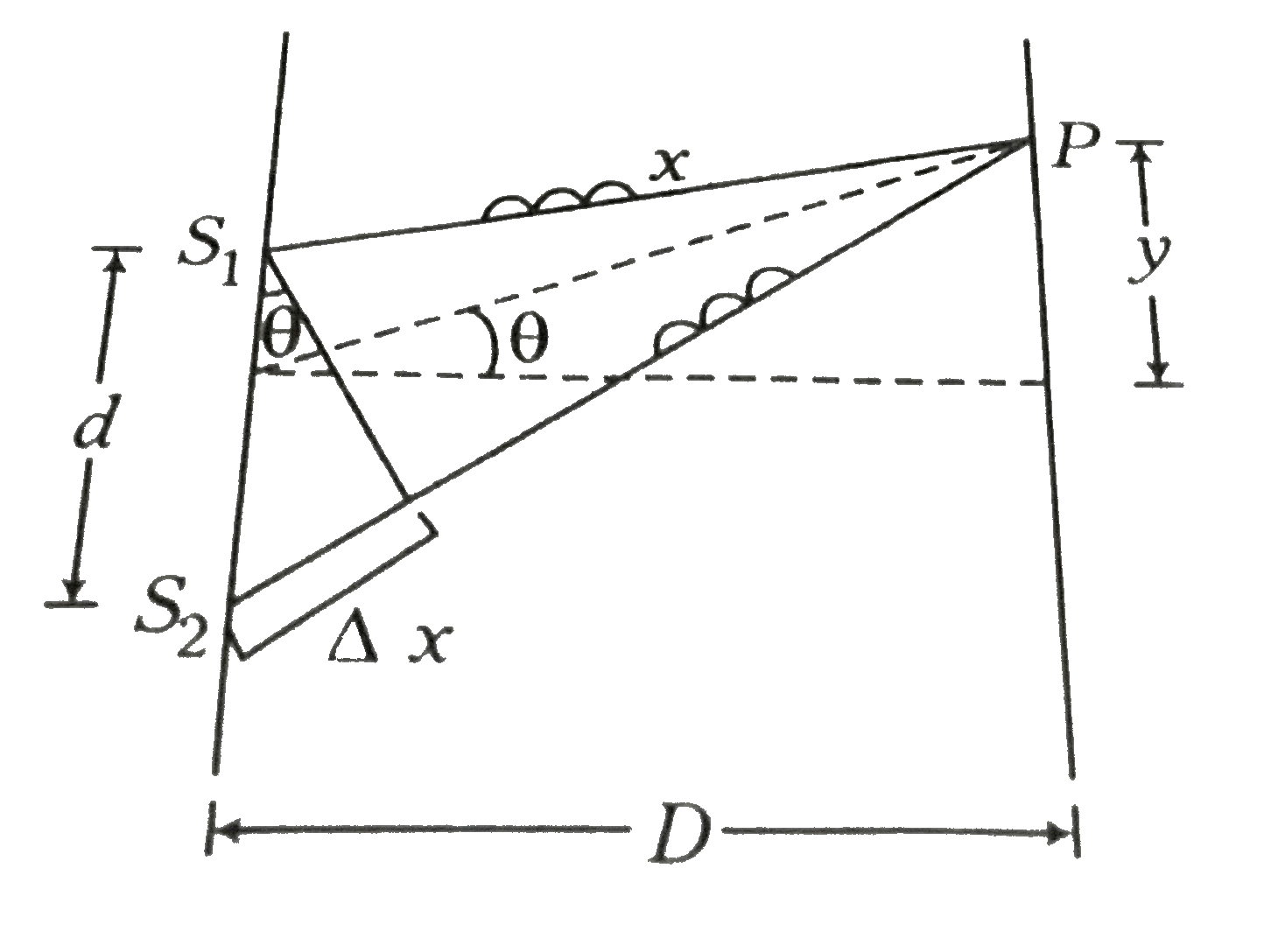In an interference arrangement similar to Young's double-slit experiment, the slits S1 and S2 are illuminated with coherent microwave sources, each of frequency 106 Hz. The sources are synchronized to have zero phase difference. The slits are separated by a distance d=150.0m. The intensity I(θ) is measured as a function of θ, where θ is defined asa shown in fig. If I0 is hte maximum intensity, then I(θ) for 0≤θ≤90∘ is given by ltbrrgt 
l(θ)=l02forθ=30∘
l(θ)=l04forθ=90∘
l(θ)=l0forθ=0∘
l(θ) is constant for all values of θ.
The correct Answer is:A, C
for θ=30∘, DeltaP=d sin 30^(@) =(150 m)xx(1)/(2) =75 m.<br>rArr Deltaphi=75xx(2pi)/(lambda) =.^(75xx)(2pi)/(((3xx10^(8))/(10^(6))))=(pi)/(2)<br>rArr I_(res)= I+I+2I cos (Deltaphi) -2l<br>whereI=(I_(0))/(4) {therefore "masimum intensity"=I_(0)=4I}rArr I_(res)=(I_(0))/(2)<br>theta=0^(@)willau→maticallycorrespond→centralmaxima.<br>theta=90^(@)willcorrespond→pathd⇔d.=150 m ,rArr Deltaphi=((150xx2pi)/(3xx10^(8)))/(10^(6))=pi<br>rArrminima<br>Hence∫esitywillbe0attheta=90^(@).
Topper's Solved these Questions
- WAVE OPTICSBOOK - RESONANCE ENGLISHCHAPTER - WAVE OPTICSEXERCISE - Exercise-2 (Part-4)
8 Videos
- WAVE OPTICSBOOK - RESONANCE ENGLISHCHAPTER - WAVE OPTICSEXERCISE - Exercise-3 (Part-1)
11 Videos
- WAVE OPTICSBOOK - RESONANCE ENGLISHCHAPTER - WAVE OPTICSEXERCISE - Exercise-2 (Part-2)
5 Videos
- WAVE ON STRING BOOK - RESONANCE ENGLISHCHAPTER - WAVE ON STRING EXERCISE - Exercise- 3 PART II
7 Videos
Similar Questions
In an interference arrangement similar to Young's double-slit experiment, the slits S_1 and S_2 are illuminated with coherent microwave sources, each of frequency 10^6 Hz. The sources are synchronized to have zero phase difference. The slits are separated by a distance d=150.0 m. The intensity I (theta) is measured as a function of theta, where theta is defined as shown. If I_0 is the maximum intensity, then I (theta) for 0lethetale90degree is given by

View SolutionConsider an interference arrangement similar to YDSE. Slits S1 and S2 are illuminated with coherent microwave sources each of frequency 2 MHz The sources are synchronized to have zero phase difference. The slits are separated by distance d= 75m. The intensity I(θ) is measured as a function of θ where θ is defined as shown in figure. if I0 is maximum intensity then calculated I(θ) for (i)θ=0∘,(ii)θ=π/6and(iii)θ=π/2

View SolutionIn Young's double slit experiment, if the two slits are illuminated with separate sources, no interference pattern is observed because
View SolutionIn Young's double slit experiment,the intensity at a point where the path difference is
View SolutionIn a Young’s double slit experiment, the source illuminating the slits is changed from blue to violet. The width of the fringes
View SolutionIn Young.s double slit experiment both the slits are similar. If width of one of the slits is doubled then
View Solution
S1 and S2 are two coherent sources of sound of frequency 110Hz each they have no initial phase difference. The intensity at a point P due to S1 is I0 and due to S2 is 4I0. If the velocity of sound is 330m/s then the resultant intensity at P is
View SolutionAn interference pattern is observed by Young's double slit experiment.If now the separation between coherent source is halved and the distance of screen from coheren sources is doubled, then now fringe width
View SolutionWhat is the effect on the interference fringes in a Young.s double-slit experimental due to each of the following operations :
The width of the source slit is increased.
View SolutionIf one of the two slits of Young's double-slit experiment is painted so that it transmits half the light intensity as the second slit, then
View Solution
